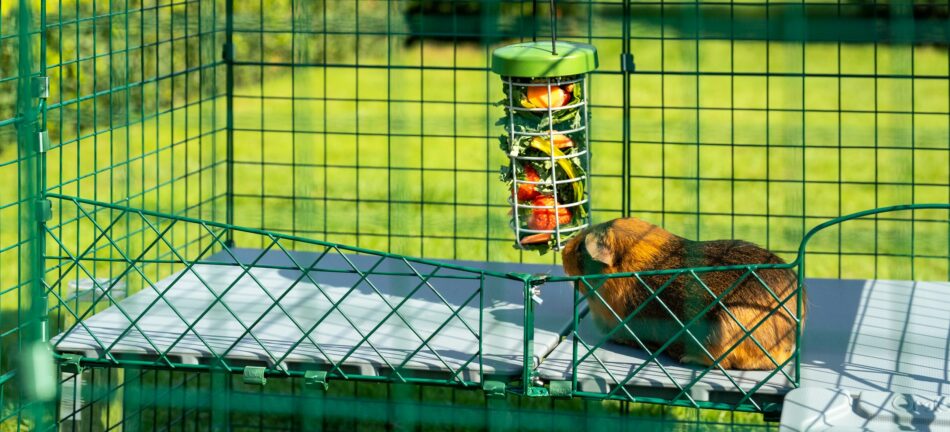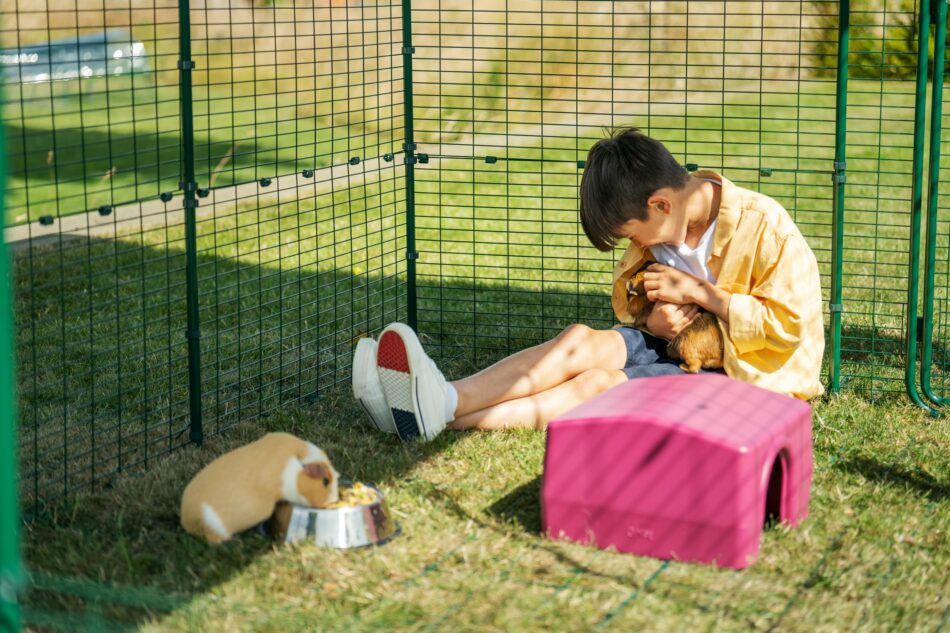Guinea pig summer safety
Guinea pig summer safety is an important undertaking for keeping cavies healthy and happy during the warmer months. Just like us, our guinea pigs can enjoy the season as long as they’re able to stay cool, hydrated, and comfortable. Omlet makes it possible for your guinea pigs to be able to weather the warmth and enjoy summer to the fullest.
Do guinea pigs enjoy summer?
Like many pets, guinea pigs are adaptable and can enjoy the warmer weather so long as:
- Your cavies are used to being housed outdoors for several hours a day
- They have plenty of water and shade
- You’re able to check in on them every couple of hours
Guinea pigs that are housed in a climate-controlled setting may experience shock from the sudden change in temperature if they’re taken out during the heat of the day. If you plan to take your indoor-raised cavy outside, make sure to introduce them to the higher temperatures gradually, starting during the coolest part of the day.
Cavies can live outdoors year-round if they’re housed in a well-ventilated and insulated guinea pig hutch. The Eglu Go Guinea Pig Hutch is designed to keep cavies comfortable in all weather conditions. The unique twin-wall insulation helps regulate the internal temperature while deflecting external heat.
Signs your guinea pigs are too hot
Recognizing the signs of heat stress in your guinea pigs is crucial for preventing them from experiencing heat stroke. Keep a close eye on both your guinea pigs and the thermometer to make sure they aren’t getting too hot outside.
Monitor for heat stroke in guinea pigs
It should be noted that even guinea pigs housed outdoors should be monitored closely when the weather warms up. Sudden temperature spikes or prolonged temperatures above 26°C can cause heat stress in guinea pigs, which can lead to heat stroke. Once cavies start to experience heat stroke, it’s very hard to reverse its effects. Not all guinea pigs will experience heat stress at these temperatures, but it’s important to keep a close eye on them regardless.
Heat stress vs. heat stroke in guinea pigs
Heat stress, or heat exhaustion, is the beginning stage of heat stroke. Heat stress occurs when your guinea pig’s internal temperature rises above their normal temperature of 39°C. Cavies experiencing heat stress may appear lethargic with heavier breathing than usual. Symptoms may appear suddenly, or come on gradually, but a guinea pig experiencing heat exhaustion can quickly progress to heat stroke. Any guinea pigs observed to be overheating should be brought into a cooler area until they act normally again.
Symptoms of heat stroke in guinea pigs
Once a guinea pig has progressed from heat stress to heat stroke, their symptoms can become serious quickly. Symptoms of heat stroke in guinea pigs include:
- Laying down – especially stretched out on their sides
- Heavy breathing or open-mouthed panting
- Dehydration
- Lethargy
- Seizures
If you see your cavy displaying any of these symptoms, bring them inside promptly. Refrain from cooling your guinea pig down too quickly – as this can cause their bodies to go into shock. Place them in front of a fan, and offer water if they are able to drink. Use room temperature water to cool them, never ice-cold. Place rags soaked in water on your guinea pigs to help cool them gradually, swapping them out every few minutes.
Call your veterinarian right away if your guinea pig does not perk up within a few minutes of being inside. Some effects of heat stroke are irreversible, even by a veterinarian, so time is of the essence. To err on the side of caution, even if your cavy perks up and acts normally after a while inside, you can still contact your veterinarian to discuss the next steps and if the event is expected to cause any lasting damage.
Which guinea pigs can get too hot?
Guinea pigs come in a variety of coat lengths and textures. Long-haired or thick-coated guinea pigs struggle the most in warm weather. These breeds include:
Because of their excess hair, they have a harder time feeling the cooling effects of a breeze or mist. They also require extra grooming to keep their coats in “working” condition. A guinea pig’s coat acts as natural insulation, keeping heat and cold away from their skin. If a guinea pig’s hair becomes matted down to their skin, they lose the insulating effects.
Another breed to take extra care with are Skinny Pigs, as they lack hair altogether – which means they have no built-in insulation to combat the heat. Though it may seem like they would be good candidates for warm weather, they are actually more sensitive to temperatures than their fully-furred counterparts.
3 tips for keeping guinea pigs cool in summer
Along with a ventilated and well-insulated hutch, there are other ways to help keep your guinea pigs cool during the summer months. Set up your cavies for a successful summer with these tips and tricks.
1. Create some shade
Your guinea pigs’ outdoor run is a great place to create shady places to relax during warmer weather. Zippi Guinea Pig Platforms not only give your cavies more room in their run, but also provide a shady spot to retreat to when the sun is out. Zippi Guinea Pig Shelters can be placed throughout the run to offer a hiding spot from UV rays as well. And, with guinea pig run weather covers you can create large shaded areas for your cavies to cool off in.
Add optional wheels and handles to your guinea pigs’ Eglu Go hutch to easily move them to a shadier spot in the yard. With the freedom to move with ease, you can relocate your piggies as often as the sun moves.
2. Offer frozen treats
Who doesn’t enjoy a good frozen treat on a hot summer day? Toss some guinea pig-friendly foods in the freezer to offer up during warmer weather. Fill a Caddi Guinea Pig Treat Holder with the chilled treats to reduce waste and help them last longer. The Caddi treat holder hangs easily from any Omlet run or other setup and can be adjusted to help piggies of all stature reach their frozen treats.
You can also freeze water bottles to place in the run or hutch with your cavies. Place the frozen bottles on their sides in a place where they won’t roll to prevent injuries. Offer 1-2 bottles per guinea pig, and watch them cosy up to these cooling containers.
3. Spend some time indoors
For particularly scorching temperatures, it may be best to bring your guinea pigs indoors during the heat of the day. You can create a safe space for them inside with a Zippi Guinea Pig Playpen so that they can enjoy the climate-controlled environment without getting into mischief. Guinea pigs’ ideal ambient temperatures are between 18-23°C. If you plan to put your guinea pig back outside, make sure not to keep them indoors for more than a few hours. The best time to bring them inside is during the hottest part of the day – usually around 3:00-4:00 pm until sunset. Once the sun goes down and the outdoor temperatures begin to fall, it will be safe to put your guinea pigs back in their home.
Omlet and your cavies
Keeping your cavies cool during the summer doesn’t have to be a chore. When you start out with the right setup, supplementing their well-being is much less work – leaving more time for summer fun with your guinea pigs. House your cavies in an Eglu Go Guinea Pig Hutch for year-round comfort, and add Zippi Guinea Pig Platforms for fun and shelter from the sun. Top their setup off with a Caddi Guinea Pig Treat Holder, and your guinea pigs will be ready to enjoy summers for years to come.
This entry was posted in Guinea Pigs


